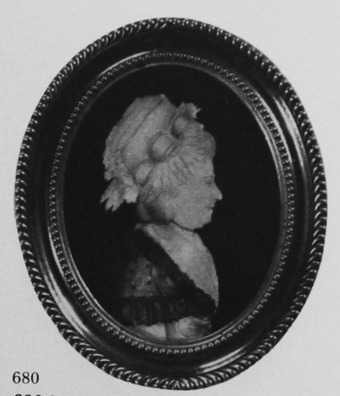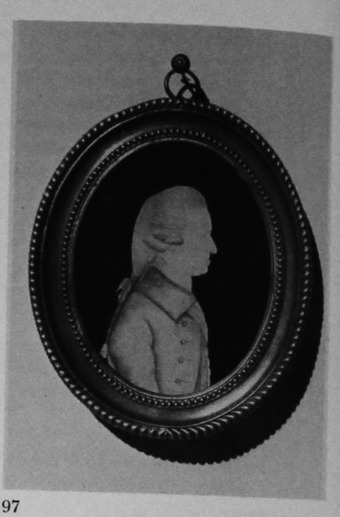Beauvais, Simon (McKechnie Section 2)
Recorded by G. C. Williamson (The History of Portrait Miniatures). Born in France, Beauvais settled in England and was working in London by 1757. He painted silhouettes in Indian ink, pencil, or both, and also painted portrait miniatures in colour. He exhibited work in both media at the Free Society of Artists, and at the Incorporated Society of Artists, 1761-78. He was awarded a premium by the Society of Artists in 1765, for his work as a miniaturist. He is known to have worked in Bath and Tunbridge Wells as well as in London and to have been a dealer in drawings and prints.
Beauvais' first name has not been established with certainty. The original Royal Academy catalogues simply refer to 'Mr Beauvais'; Bénézit refers to an artist named Simon de Beauvais. Foskett pointed out that it was still uncertain whether or not there were two artists named Beauvais at this period (Simon and John), and she included an entry on each. She also refers to the writer of a review of Basil Long's British Miniaturists in the Connoisseur (February 1930), who discusses the evidence then available about Beauvais' first name. It seems that the name of Simon Beauvais appeared in a scarce List of the Society of Gt Britain owned by the reviewer. This list was published between the close of the Society's exhibition in 1772 and the opening of its exhibition in 1773; it did not include an artist named John Beauvais.
Williamson refers to the artist as Simon Beauvais in The History of Portrait Miniatures. Samuel Redgrave, in A Dictionary of Artists of the English School (London, 1878), mentions that the premium of the Society of Arts was awarded to John Beauvais in 1765, but also mentions that Simon Beauvais was elected a Fellow of the Society of Arts in 1771. Graves lists the artist as Simon Beauvais in The Society of Artists of Great Britain, giving the following entries for exhibits at the Society of Artists and (the last entry) the Free Society:
1761-63 5 miniatures
1764-67 5 miniatures Mr Bennist's, in St Martin's Lane, Leicester Fields
1768-70 6 miniatures At Mr Bryan's, St Martin's Street, Leicester Square
1771-74 10 miniatures At the Blue Bull, St Martin's Street
(2 in Indian ink)
1775-78 5 miniatures Mr Blade's, Cabinet Maker, in Market Street, St James's Market
1762 3 portraits
Unless there were indeed two artists, Simon and John Beauvais, it seems probable, making allowances for the contradictory nature of the evidence, that the first name of the artist considered here was Simon.
Graham Reynolds, in English Portrait Miniatures (London, 1952), gives an alphabetical list (taken from Mortimer's Universal Directory for 1763) of painters of portrait miniatures who were working in London during that year. Beauvais heads this list of twenty-four artists. The list is not necessarily complete, since, as Mr Reynolds points out, not every artist would necessarily have troubled to send in an entry for publication. Beauvais' own entry (page 4 of the Directory) reads as follows: 'Beauvois ⎯ Miniature Painter and Dealer in Capital Prints and Drawings. Opposite Long's-Court, in St. Martin's Street, Leicester-Square.'
G. C. Williamson writes that Beauvais had the 'unenviable notoriety' of being one of the dirtiest men of his day. He quotes from Book for a Rainy Day, by John Thomas Smith (4th ed., London, Methuen, 1905), a passage about Beauvais which no doubt refers to his behaviour in an auction room which he visited in order to acquire prints:
This man, who was short and rather lumpy in stature, indeed nearly as wide as he was high, was a native of France, and through sheer idleness became so filthily dirty in his person and dress, that few of the company would sit with him. Yet I have seen him in a black suit with his sword and bag, in the evening of the day in which he had been at Court, where for years he was a constant attendant. This Sack of Sand' as Suett the actor generally called him, sat at the lower end of the table; and as he very seldom made purchases, few persons ventured to converse with him. He frequently annoyed Hutchins by the loudest of all snoring; and now and then Doctor Wolcott would ask him a question in order to indulge in a laugh at his mode of uttering an answer, which Peter declared to be more like the gobbling of a turkey-cock than anything human. He lived in a two-pair of stairs back room in St. James' Market, and after his death, Hutchins sold his furniture.
Smith concludes: 'I recollect his spinet, music stool, and a few dog-eared sheets of lessons sold for three-and sixpence.'
Two of Beauvais' advertisements (referring to his work, in Indian ink and lead pencil as well as in col-our, at Tunbridge Wells) appeared in The Public Advertiser during 1757 and c. 1763, and have been reprinted by Williamson. The first advertisement reads as follows:
MINIATURE PAINTING
Mr. Beauvais, well-known at Tunbridge Wells for his Performance, begs leave to acquaint the Nobility and Gentry that he continues to paint Portraits in Water Colours, or India Ink, in which he has hitherto given general satisfaction as to the Likeness: he teaches also by a peculiar method, those of the least Capacity, to take off in a short time, a Likeness in Black Lead, or India ink, Miniature Pictures faithfully copied by him to any Size, and all kinds of Pictures, Prints, and Drawings, from the most Capital Masters, to be sold.
To be spoke with at his Lodgings at Mr. Benoist's in St. Martin's Street, facing Long's Court, Leicester Field; every day from Eleven to One.
This advertisement implies that Beauvais had already visited Tunbridge 'Wells on more than one
previous occasion. The second advertisement indicates that he returned to the same lodgings at Mr. Benoist's house:
MINIATURE PAINTING
Mr. Beauvais, who is lately returned to Tunbridge Wells to his Lodgings at Mr. Benoist's in St. Martin's Street, begs leave to acquaint the Nobility, Gentry, and others, that he continues to paint portraits in Miniature in Watercolours or Indian Ink, at reasonable Prices in which he has hitherto given intire Satisfaction: He teaches also Drawing in all its Branches and Painting. He has likewise a large Number of Capital prints and Drawings purchased out of the test Collection to dispose of.
That Beauvais was still working both as a portrait miniaturist in colour and as a profile-painter in Indian ink or water-colour in the early 1770s is evident from another advertisement which is preserved in the book of old press cuttings in the Victoria and Albert Museum, London. The cutting is dated 1773 in a contemporary hand.
MINIATURE PAINTING
MR BEAUVAIS, well known at Tunbridge Wells to several of the Nobility and Gentry for taking a striking Likeness, either in Water Colours or India Ink. Miniature pictures copied by him from large Pictures, to any size, and Pictures repaired if damaged. He also teaches by a peculiar Method Persons of the least Capacity to take a Likeness in India Ink, or with a Black Lead Pencil, in a short Time. To be spoke with at Mr. Bryan's, the Blue Bull, St. Martin's Street, Leicester Fields, from Eleven to One o'clock.
A curious Collection of Prints and Drawings to be sold at the lowest Prices.
We know from Beauvais' advertisements that he painted miniatures in water-colour, as well as taking likenesses. There is, however, no record of any signed miniature or profile by him, and, since other artists painted profiles in Indian ink, this makes it difficult to assign work to Beauvais with certainty, especially since no trade label of his is known. One would have expected that a profilist who was also a miniaturist would have signed his work.
The reference to the use of lead pencil is unusual; early silhouettes in pencil, or in pencil and Indian ink, might be attributed to Beauvais, if with some diffidence.
I have seen three profiles drawn mainly in pencil with surrounds in black wash, which may possibly be by Beauvais and which I have illustrated. They do at least indicate the type of work which one might expect artists working in the style suggested by Beauvais' advertisements to have produced. These three profiles date from the late 1770s (we know. from Graves's list that Beauvais was working as late as 1778).
97, 680, 681
I should mention two sets of initials, recorded by previous writers, which might be those of Beauvais. A cursive monogram, 'J. B.', dating from 1768, was recorded by Long; I have suggested that it might refer to J. Brockmer (q.v.), but it could refer to John Beauvais. Foskett records the initials 'S. B.' on a coloured miniature of the Madonna and Child dated 1787, but this seems rather late to refer to Beauvais.
Ills. 97, 681, 682

Unknown woman
Profile on card, in pencil and either black water-colour or Indian ink
c. 1779-80
3½ x 2¾in./90 x 70mm.
Frame: oval, hammered brass
This silhouette, which is unsigned, is in the style referred to in Beauvais’ advertisements.
Author’s collection

Unknown woman
Profile on card, in pencil and either black water-colour or Indian ink
c. 1781
3½ x 2¾in./90 x 70mm.
Frame: oval, hammered brass
This silhouette I similar in style to the example shown in 680.
Graham Robinson collection

